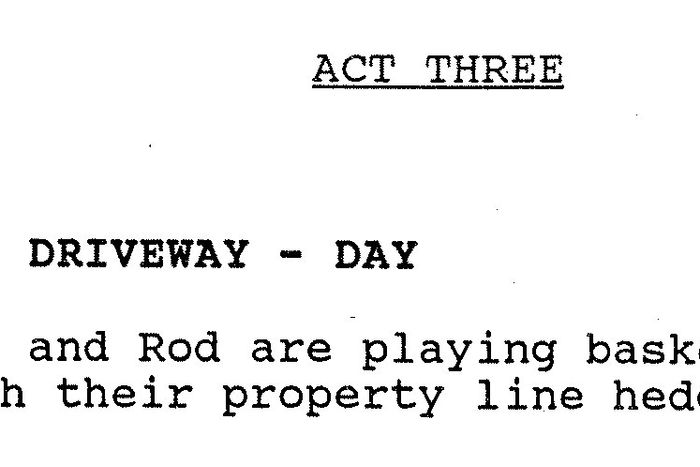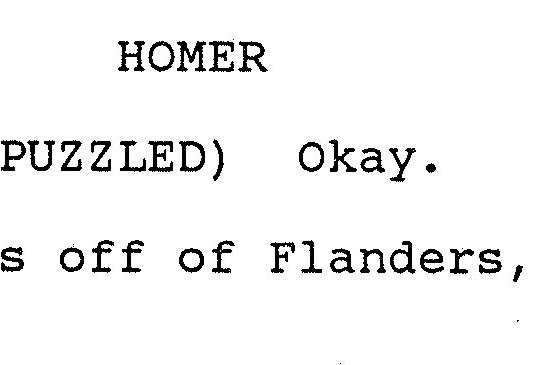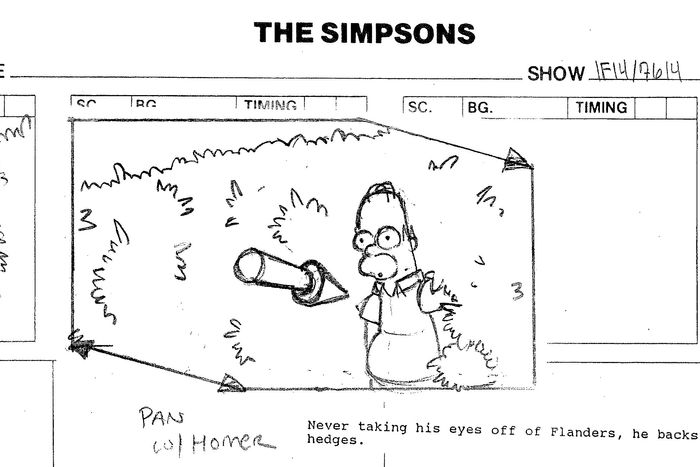
If you spend any time online, you’ve seen it: a short GIF of Homer Simpson disappearing backward into a hedge, his eyes wide open — a visual “don’t mind me.” Taken from a 1994 episode of The Simpsons, it’s generally used as a reaction to express embarrassment or the desire to disappear from an awkward social interaction, a longing for an exit so seamless that it’s like you were never there. But before it appeared on The Simpsons, and long before it took on its final form as a meme, the concept of inter-hedge travel was just an idea in the head of a sci-fi-obsessed kid running around the suburbs of northeast Philadelphia named David Mirkin.
Mirkin, who was the Simpsons’ showrunner when the episode aired and still works on the show today, spoke with Vulture about the meme’s origin.
“Him coming through the hedges was based on my childhood behavior of walking through hedges in my neighborhood. I would pretend that I was dimension-hopping,” Mirkin says. “You can only do it a few times before you leave a hole, and so I did tens of thousands of dollars of damage to people’s hedges I’m sure.”
As a child, Mirkin — who worked as an electronics engineer before becoming a writer and director — devoured movies, comics, and horror magazines, as well as science-fiction shows like Star Trek, The Outer Limits, and The Twilight Zone. “I was incredibly obsessed with all of that,” he recalls. “It was around the time of 2001 [A Space Odyssey] too, which was dimension-hopping, stargates, and stuff like that.”
That idea of hedges as suburban stargates stayed with him until it made its way onto The Simpsons in season five, episode 16, “Homer Loves Flanders,” a morally nuanced episode written by David Richardson in which Homer has a sudden desire to befriend his irritatingly Christ-like neighbor Ned Flanders and, in the process, ruins Flanders’s life.
Mirkin wanted to subvert the common sitcom trope of the annoying neighbor who always pops over uninvited and put a twist on it. This led to Homer’s mounting obsession with Flanders, which goes from endearing development (“Nacho, nacho man!”) to surreal nightmare over the course of the episode as Homer’s bone-deep ignorance of common decency and personal space slowly drive Ned to the brink of destruction. As Mirkin puts it, “[Flanders] was always hopeful of being more friendly with Homer, and always trying, and getting his wish and that actually happening turned into his worst possible nightmare.”
It’s a dark episode, even by Simpsons standards, and the moment Homer emerges like a liquid hologram from the bushes marks the exact moment where his behavior goes from overbearing to scary. After a scene of biblical corruption in which Ned tells what might be his first-ever lie to get out of spending more time with his neighbor, Homer says “Oh, okay” in a monotone, then melts, unblinking, back into the bushes.
Mirkin says he pushed animation director Wes Archer and his team to make the motion as smooth and slow as possible for maximum unsettling effect, and he attributes the meme’s popularity largely to the striking, uncanny quality that their meticulous work achieved. “I’m really proud of it because I had to have the animators do that motion — both coming out and going back in — about five times to get it slow enough and detailed enough so that it felt right to me, because I wanted it to be a kind of a magical, creepy thing,” he recalls.
Indeed, the movement is distinctly unlike Homer — smooth and disturbingly effortless rather than clumsy – resulting in something along the lines of Homer Simpson, Transdimensional Hedge-Monster.
The website Know Your Meme has a useful rundown of how “Homer Simpson Backs Into Bushes” became the all-conquering meme it is today. It reportedly first appeared in 2010 on a site called GIF Garage under the heading “Homer appears, then disappears in bush,” though it doesn’t seem to have caught fire at that point. Its profile was raised in 2012 when a Tumblr blog posted a version of the GIF with a blank background that allowed users to replace the hedge with other images, spawning remixes like Homer backing into a wall of pizza, which resulted in a post on Uproxx titled “Homer Backs Into Things Is The GIF Theme We Need Right Now.”
A Reddit post from 2014 advertised a “Homer backing into things generator,” hosted on the now-defunct URL “HomerBacksIntoThings.com,” encouraging Redditors to make new versions of the meme, resulting in further media coverage. Once it hit the mainstream, the meme mushroomed on Twitter, where quick-fire reaction GIFs are king. According to Know Your Meme, the meme gained additional traction as a panel of four images, rather than as a GIF, in 2014 when people used it to roast fair-weather fans who “disappear” when their team is losing, resulting in its inclusion in various lists of the funniest memes about the Super Bowl and the 2014 World Cup.
There are many other highly popular Simpsons memes (Grandpa Simpson’s “Nothing To See Here,” Lisa giving a presentation, and that evergreen plea for online mercy: “Stop! He’s already dead!”), but “Homer Backs Into the Bushes” remains the most ubiquitous. It’s even inspired a browser game called Hide Homer.
It’s the nature of memes to be shorn of their original context and used as emotional shorthand, often with no regard for their original meaning. As Mirkin points out, the Homer meme is no exception. “What’s really interesting is the meme really has nothing to do with the way it was used in the show, because it’s not a retreat or an embarrassment, as it’s used — it was really just an ominous, threatening look and a very weird backing up while never breaking eye contact with Flanders,” he says. “So it’s great the way it’s been changed, but it’s not the original intention.” He notes that while people have reinterpreted Homer’s expression as one of shame, “it’s a creepy stalker energy instead of an embarrassed, retreating energy.”
Mirkin adds that another common misconception about the sequence is that people often think it’s a Terminator 2 reference, which, he concedes, is an easy mistake to make considering the almost shot-for-shot Terminator homage that immediately follows, in which Homer robotically chases down Ned’s sputtering Geo as the Flanders family desperately tries to escape his affections.
At this point the meme has become so well-known that it’s even been referenced on The Simpsons itself, making it that rare unit of entertainment matter that makes the orbital journey from TV to cultural absorption and back again to its original medium.
It was Cesar Mazariegos, a new Simpsons hire and one of the youngest writers in the room, who pitched the idea of Homer texting his own meme in the season 30 episode, “The Girl on the Bus.” Mazariegos, who previously created the comedy High & Mighty, says that it may in fact have been his first joke that made it onto The Simpsons.
“I was brand new. It was literally my first week,” he says, explaining that he pitched the idea at a screening of the episode’s animatic (essentially a rough cut). The episode had been written before he joined the writing staff, and when producer Al Jean and the writers decided that a scene in which Homer texts Lisa “needed a pop” at the end, he tossed out the idea and it got a laugh.
The internet loved the reference-within-a-reference, and even Time magazine covered the rare instance of the Simpsons universe folding in on itself. Mazariegos was stunned by the reaction.
“I’m showing it to my wife like, ‘Yo check this out, I pitched this like my first week there!’” he remembers, calling the positive response “a pretty fun, cool way to get welcomed into the Simpsons fold.” Like most of the meme’s users, Mazariegos grew up watching The Simpsons, taping it on a VCR to watch over and over. “So when I saw it as a meme, of course it went into my phone,” he recalls. He agrees that the meme’s popularity is down to the quality of the animation as well as the meme’s versatility. “It’s the perfect button to, you know — you’re having a conversation and it’s a TMI moment or like an ‘I don’t need to be here’ moment. It fits into whatever people are trying to say in that moment.”
As far as Mazariegos knows, this is the first time The Simpsons has referenced a Simpsons meme on the show, at least so explicitly. As for meme culture, he drew an analogy with early New York City rap.
“These GIFs are kind of like sampling — little snippets, removed from their original context and repurposed into a whole new creative thing,” he says. “You can hate on it or you can embrace it, and I think it’s cool that the show gave a little wink and embraced it.”
After 30 years and going on 700 episodes, The Simpsons has put so many jokes and ideas into the ether that it seems inevitable that some would mutate and bubble back up in unexpected ways, including as memes.
“It’s a great compliment,” says Mirkin of the cultural feedback loop The Simpsons has created. “It’s one of the greatest gifts you can have as a writer, because you go, ‘Oh yeah, that made an impact — that hit people in the imagination’ … We’re always thrilled with that, and it really is the goal to get as much of your stuff out there into the culture as you possibly can, because it’s guaranteed that you will live forever when that happens and never die.”
Though it’s been decades since Richard Dawkins coined the term “meme” for ideas and cultural artifacts that propagate themselves by “leaping from brain to brain,” exactly how memes work is a bit of a mystery.
We all know what a meme is, but as for how and why some become part of the vernacular while most blink out of existence almost immediately, that’s still anyone’s guess. Memes remain more alchemy than science.
Mirkin, whose other work has included Romy and Michele’s High School Reunion and the surreal sitcom Get a Life, says he’s always looking “for images and moments that you haven’t seen before,” and that impulse toward novelty may be the most anyone can do to create something indelible. After that, the culture takes over. Make it weird and different enough — like Homer teleporting through a hedge — and maybe it’ll stick.
“And then if you’re also lucky that it has some sort of art to it, some sort of look that is striking in addition to being something you haven’t seen before, you have some sort of a chance that it’ll hit people just right,” he says.
But, he adds, there’s still a lot of luck involved.
“The timing has to be right, and it’s impossible to ever guess what the public will be super excited about and what, no matter how excited you are, they’re going to completely ignore or hate. That’s part of the fun of it.”
“It really is a roulette wheel, and you’re just happy when something works. “







